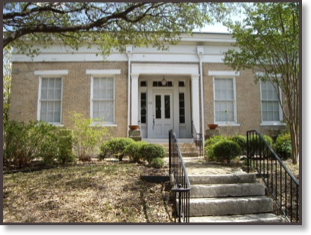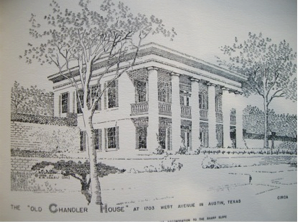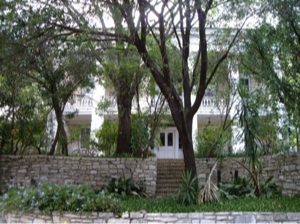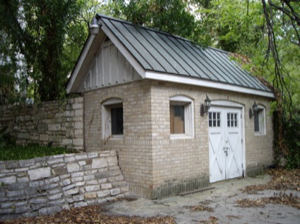Old Judges Hill Historic District
A Proposed Austin Local Historic District
Chandler-Shelley House, aka Westhill - 1855

Historic Use: Residence, Fraternity house
Current Use: Office
Recorded Texas Historic Landmark
City of Austin Historic Landmark
This fine antebellum home was in all likelihood built on a hill just west of the Capitol by Abner Hugh Cook and his son about the same time he built the Governor’s Mansion. Both buildings feature Cook’s signature clustered-stick balustrades and similar interior woodwork. Westhill’s grand double-gallery entrance with six fluted, cypress-staved Greek Doric columns faces Rio Grande and the Capitol; visitors originally reached the house via a casual entrance on West Avenue or via the “carriage” entrance to the ground floor by way of a sweeping semicircular flagstone drive from Rio Grande. The cornice gorge is accented by a necklace of dentils. Interior framing and trim are pine, and flooring is wide pine plank.
Built to accommodate the sloping terrain, with Austin limestone forming the lower walls and brick masonry above, this unique split-level Greek Revival home is believed to have been constructed about 1855 for Mary and Reuben Runner, who were issued a homestead patent for the property by Governor Pease in November of 1854. Mary Runner was an assignee of G.K. Lewis, first settler to buy the land circa 1940.
The kitchen and cistern were separate, northwest of the house, serving through the north doorway.
The Runners sold Outlot 20 and buildings in 1858 to merchant Nathaniel Townsend (1804-1864), whose relative, Caroline Townsend, in 1863 sold it to Colonel Frederick W. Chandler, a Civil War veteran and prominent Austin attorney as well as the secretary-treasurer of the Austin City Water Company. Chandler came to Texas from Massachusetts and apparently purchased Westhill with Confederate money. He and his wife Fannie had one daughter, Cornelia who first married a Mr. Rice, and later married the general land agent and brickmaker-contractor Henry E. Shelley, a brother of Texas attorney general (1862) and three-term state senator Nathan G. Shelley. Henry moved in with the Chandlers by 1872 and became an attorney and notary by 1881. In the late 1890s Henry became the superintendent of the Confederate Home and later member of the board of pardons and prison advisors.
Alabama senator Jacob D. Shelley fathered six children, including Robert, Henry E. Shelley (1841-1906?), and Sarah Francis Shelley. (Thus Henry, who owned the Chandler-Shelley home, was an uncle of G.E. Shelley, who lived across the street from Westhill beginning in 1928.) Sarah married her first cousin, in 1853 – attorney, Alabama and Texas legislator, and Confederate officer Brigadier General Nathan George Shelley (1825-1898). Born in Tennessee to William Parke and Margaret F. (Etter) Shelley, Nathan moved from Alabama to Austin in 1855 and served as the attorney general of Texas (1862). The family’s home was on Blanco Street. Nathan and Sarah owned a large piece of property between 12th and 13th Streets, Blanco and West Lynn, which may have run to the river at one time. When G.P. Shelley was a boy, west of Shelley Avenue was a pasture. Windsor Oaks is now where the Shelley home was located. Shelley Street is named for the Shelley family. Nathan and Sarah’s oldest son William D. Shelley (c1857-1928) was the mayor of Austin 1905-07. James “Bosun” (illiterate), Pearcy and Lula (blind) were William’s siblings.
Travis County Judge A.S. Thompson Jr. resided in the home in 1898-99. Westhill became the Phi Kappa Psi Chapter House about 1906, and in 1909, the Shelleys’ daughter Louise sold Westhill. May (Mrs. Charles M.) Thompson and her children owned and resided in the home from 1917 until 1969, when it underwent major restoration by the Travis Williamson family.
Westhill’s original Carriage House, 707 West 18th Street, is used as an office. Westhill originally had a separate kitchen and other outbuildings.


